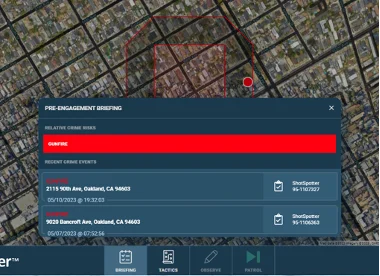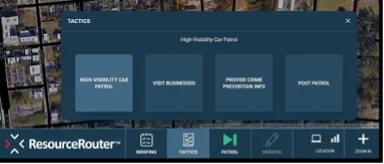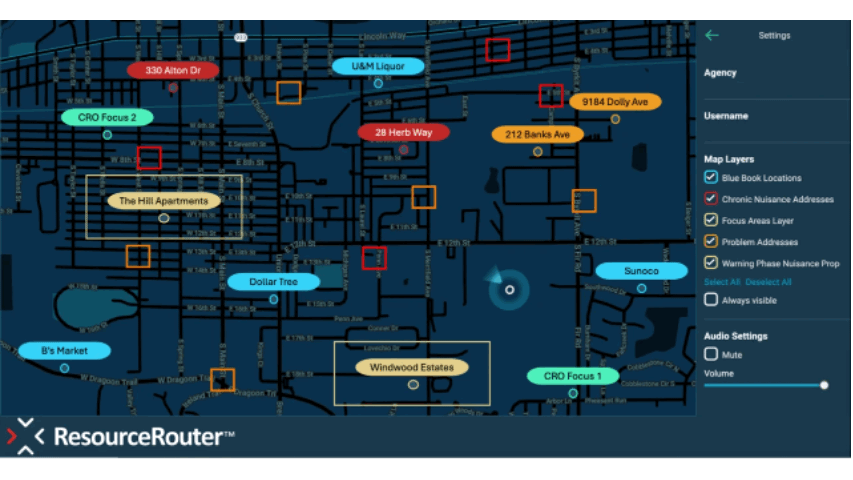If police work was a safe and easy job, everyone would want to do it. Unfortunately, it is neither, which has been particularly evident in recent years. In fact, according to the National Law Enforcement Officers Memorial Fund, on average, over 16,000 police officers per year have been injured on-duty as the result of an assault since 2012. Of course, this does not factor in the number of line-of-duty deaths, which reached a staggering 250 in 2022, and 123 in 2023. Here at SoundThinking, officer safety is an issue near and dear to our hearts. Our ResourceRouter directed patrol management solution offers several key features that improve officer safety, so that officers are better equipped to provide that same safety and peace to the communities they serve.
One of the most pressing problems currently facing police agencies nationwide is a decrease in manpower. Officers are leaving law enforcement at rates greater than hiring can keep pace with. Less officers on the street means there are fewer officers patrolling larger areas than what is safe, reasonable and effective. A high crime area that once had several officers available to address crime issues, now may have only one or two, leaving those officers more vulnerable. How does ResourceRouter help address this issue?

250 meter by 250 meter generated patrol boxes for non-enforcement based activity.
By combining the use of non-people specific police data with environmental factors that can contribute to crime occurrence, ResourceRouter uses advanced computer-modeling to forecast where certain crimes are most likely to occur. This allows agencies to direct their officers to these small, manageable, metered patrol boxes three times a day, for short, 15-minute periods, to engage in non-enforcement, community engagement-focused activity. Per the work of George Mason University professor Dr. Christopher Koper, such tactics provide several hours of crime deterrence in those specifically metered, high crime areas. Over time, this deterrent effect can add up to less crime, and in turn provide an increase in officer safety through fewer crime-related encounters.
In policing, access to relevant information can be the difference between injury and safety, and even life and death. However, with less officers and an average of over 657,000 emergency 9-1-1 calls nationwide per day, agencies are in a rush to get their officers on the street as quickly as possible. This means less time to pass on important safety information, such as recent crime events, to officers in the field. ResourceRouter pulls crime information from an agency’s records management system (RMS) for each metered patrol box it produces, updated each shift, at the click of a button. Officers are now made aware of the specific crime types most likely to occur in their assigned box, and what crimes have occurred in and near that area over the last 7 days.

Recent, situational crime data is available to officers before they engage in activity while in the box.
Officers can now engage in the desired activities with more situational awareness, thus keeping them better prepared to face risks they may encounter.
A level of trust and mutual respect between officers and the community must exist to keep everyone involved safe. When citizens don’t trust officers, they are much less likely to willingly engage with police to provide witness accounts, neighborhood information and general support of law enforcement activity, which can be problematic for both the police and the community.

Officers choose non-enforcement activities, determined by their agency, to perform while inside the patrol box.
Officers get the chance to show citizens that they care and are listening to their concerns, beyond just criminal activity. They are present, without being overly intrusive. This helps builds community trust, which creates a partnership to facilitate peace and safety.
Law enforcement is a very dynamic and often overwhelming duty. The safety of those who chose a career that carries such high-level risk, must be a top priority in the goal to end violence and keep the peace. In our quest to continually do Work that Matters here at SoundThinking, ResourceRouter delivers on that goal by providing police officers with a solution that helps increase their safety, so they too can continue to do Work that Matters.





